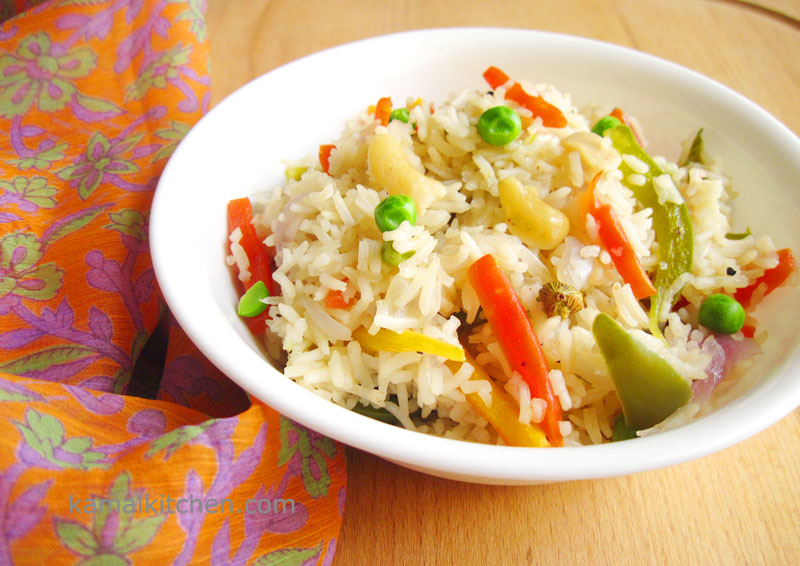Vegetable Pulao or vegetable pilaf as it is called in some parts of the world is a really simple recipe. And its the one to try if you are new to Indian cooking or Indian food. Veg Pulao has come a long way over the years and there are many different versions floating around on the web. My vegetable pulao recipe is probably the oldest, and the one I love best.

The key ingredient for a traditional Indian Vegetable Pulao is good quality Basmati Rice. Basmati Rice is easily available in many places, and is no longer an unheard of ingredient. If you have a choice of brand, Tilda, Dawat, Royal are all good. I prefer Tilda myself. The next important ingredient is whole spices – cloves, cinnamon sticks, cardamom and bay leaf. Lets not forget Shuddha Desi Ghee or Ghee or clarified butter. Ghee is also available in super markets nowadays, and certainly in Indian grocery stores. Or you can make your own at home using sweet cream butter.
The vegetables and nuts are like jewels that adorn the pure white delicate rice grains. Vegetable pulao can be enjoyed on its own or served with a Dal or Curry.
The recipe is as follows –
Ingredients
2 cups Basmati rice
2-3 Tbsp ghee
1 Tbsp vegetable oil
4 cloves
4 green cardamom pods
1 inch cinnamon stick
2 dry bay leaf
1 Tbsp black peppercorns
1/2 cup finely sliced onion
1/2 cup finely slivered carrots
1/2 cup cpasicum strips
1/2 cup green peas
1 Tbsp fresh ginger garlic paste
10-12 cashews broken
3-4 whole cashews for garnish
salt to taste
Method

1. Wash and cut the vegetables in similar sizes and shapes. Set aside. Blanch or defrost peas and set aside.
2. Wash the rice and assemble all the whole spices in one place.
3. Heat ghee and oil in a saute pan. Adding oil prevents the ghee from burning. As the fat heats, add the whole spices and allow them to splutter.
4. Add the cut vegetables one by one except the peas.
5. Add the ginger garlic paste. You can also directly grate in whole ginger and garlic cloves into this.
6. Add the broken cashews.
7. Now add the washed and drained Basmati rice. Stir gently. Avoid breaking the grain of the rice.
8. Add 4 cups of water and salt to taste. You can add veggie broth if you wish, but the water is good enough.
9. Now, if you are using an electric rice cooker, you can just transfer all this to the rice cooker container, switch it on and forget about it. The rice cooker will auto shut off after all the moisture evaporates, and will give you dry fluffy rice every time.
10. If you are not using the rice cooker, bring the mixture to a boil and cover with a lid. Lower the flame so that the pulao doesn’t burn at the bottom.
11. Check if the rice appears cooked. After most of moisture is absorbed and the rice is almost al dente, cover until some steam builds up and switch off heat. If you have an electric stove, transfer the pot to a cool surface.
12. Set aside for up to 30 minutes. The rice will cook in the residual heat and steam and give you a fluffy texture.
Vegetable pulao is ready to be enjoyed. Easy though it looks, cooking rice is not always an exact science. The liquid to be added depends on how new or aged the rice is. 2 cups of water per cup of rice is a standard measure, but you might need more or less sometimes. A rice cooker is a good appliance to have to prevent ending up with soggy or uncooked rice.
I hope you enjoy this simple and rich vegetable pulao recipe.
Please Note: There is NO turmeric here.


Leave a Reply